Where Biology and Chemistry Meet
After three days of overcast skies and whitecaps, today the wind settled and the sky cleared. Sun warmed the observation deck on the bow, and stiff-winged snow petrels flittered among the waves as if impatient for the wind to return. We had steamed south about 120 miles to get some more information from an interesting area we had visited last week.
The ship coasted to a stop around 2 p.m. and the CTD rosette went over the side. Teams began sampling water for another round of experiments. One of these groups was the team led by Dr. Adam Kustka of Rutgers University. They are testing how phytoplankton respond when they are given Modified Circumpolar Deep Water or extra iron. Read on through the slideshow to meet the team:
- Dr. Kustka’s team consists of five people, and he is constantly working to ensure the experiments go smoothly. This entails troubleshooting equipment, filtering water, dashing out to the trace-metal van and the ‘bubble,’ and organizing samples in a cold room called Little Antarctica. From morning until late at night he’s on the move, windproof overalls pulled up over his t-shirt, jotting notes and calculating amounts for his next experiment on his notepad.
- Lora McGuinness, a lab manager at Rutgers University, prepares a water sample from the bottles brought up on a CTD rosette. Lora has been doing molecular analysis for 20 years. She learns which species of phytoplankton are living in Dr. Kustka’s samples by isolating and analyzing DNA in the water sample. Lora said she prefers research voyages in the tropics—one of her favorites went from Puerto Rico to Trinidad. ‘But everybody in oceanography would love a chance to go to Antarctica once,’ she said. So she came.
- Research technician and graduate student Ashley New places water samples in the Blue Room to incubate. The phytoplankton must be kept at the temperature they’re used to in the ocean. So even though ‘incubate’ usually means keeping things warm, this room is freezing cold. A wall of 48 blue lights make sure that all the phytoplankton have the same amount of light to grow in. This keeps cloudy or sunny weather from interfering with the experiments. Over the next 9 days, the researchers will measure the phytoplankton’s growth and see whether the iron, MCDW, or other factors they added have had an effect.
- Ashley prepares a sample of phytoplankton from an earlier incubation. She filters 200 milliliters (about 3/4 of a cup) of her sample through a glass-fiber filter to trap the living cells. The filter paper looks greenish because the cells contain chlorophyll, which Ashley will measure next. She said she doesn’t mind all the filtering that her research requires. ‘I enjoy biology, and I enjoy chemistry,’ she said, laughing. ‘And I like it best where they meet and get very confusing.’
- On an upstairs deck at the stern of the Palmer, Dr. Cecile Mioni of the University of California, Santa Cruz is inside the Rad Van. Here she adds mildly radioactive carbon and iron to water samples. The materials don’t hurt the phytoplankton, but the radioactivity makes it easy to track how these elements get used by the various phytoplankton species. Dr. Mioni grew up near Bordeaux, France. She can’t wait for the Rugby World Cup this year, when the French national team may get a chance to beat the New Zealand All-Blacks.
- Dr. Kustka puts a water sample into a clear-plastic incubation tank on the deck of the Palmer. Unlike the samples in the Blue Room, these will stay on deck and grow under natural sunlight. The big tank has seawater continuously pumped into it to keep the phytoplankton at the right temperature—which is very close to freezing. I think that’s why Dr. Kustka is grimacing as his hands go into the water.
- If you’ve ever been to the beach and smelled the ocean’s seaweedy smell, you know a little about what Menglei Chu studies. That smell comes from dimethyl sulfide, a gas that can affect the planet’s climate. Menglei is trying to discover how nutrient supplies affect how much of the gas is made by an abundant kind of phytoplankton called Phaeocystis. Menglei is in his first year as a graduate student at Rutgers. He is from Zheijiang province, China. It was in middle school that his interest in biology began, he said. He liked getting to look through a microscope at tiny cells, and has been studying them ever since.
- At midnight we found out it was Dr. Kustka’s birthday. We were all in the galley (kitchen), eating a meal called ‘midrats,’ or midnight rations, which are cooked for people who have to stay up late. It wasn’t just any birthday—it was his 40th birthday. We didn’t have any candles on hand, so chief scientist Dr. Josh Kohut stuck two slices of bacon into a donut and we all sang ‘Happy Birthday’ at the tops of our voices.
In the evening the ship set course for a long steam back to McMurdo Station, where we will refuel. (We still have plenty of fuel, but the Palmer has a long voyage back to South America after our trip ends, and this is its best chance to refuel.) Getting to McMurdo will take all day tomorrow, but after we refuel we’ll head back out for another two and a half weeks of research.
From up on the bow, delicate mare’s tail clouds curled across the blue sky, and the low midnight sun lit the southern horizon. We passed a group of about 30 orcas that were spread out on either side of the ship. Their spouts were visible all around, and their long dorsal fins stood high over the waves as they broke the surface. Tomorrow, we’ll see Mount Erebus and Ross Island on the horizon again.


 January 27, 2011
January 27, 2011 
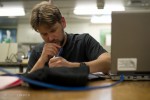
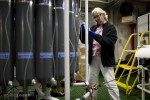
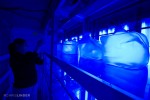
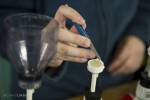
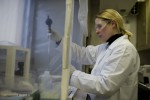
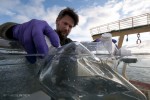
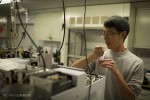
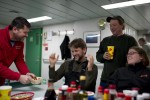







25 Responses to “Where Biology and Chemistry Meet”